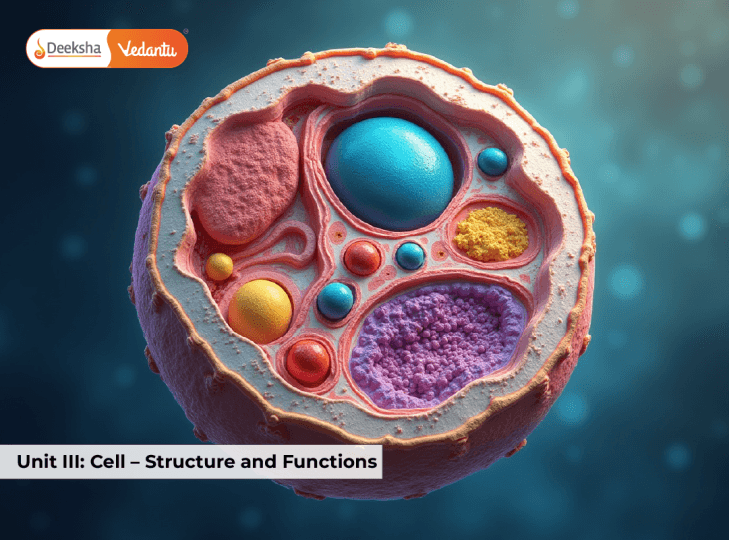Unit III of Class 11 NCERT Biology, “Cell: Structure and Functions,” is a cornerstone of NEET preparation. It introduces students to the microscopic units that constitute all life forms — cells — and explores how their components work in harmony to perform complex functions. Understanding this unit is essential because it lays the groundwork for genetics, biotechnology, molecular biology, and physiology covered in Class 12.
This unit builds upon the organizational concepts explored in Unit II: Structural Organisation in Animals and Plants, delving deeper into the fundamental unit of life — the cell.
Chapters in Unit III
This unit comprises three chapters that form the backbone of cellular biology:
Chapter 8: Cell – The Unit of Life
- Origin and development of cell theory.
- Types of cells: prokaryotic and eukaryotic with key differences.
- Detailed structure of a generalized cell including plasma membrane, cell wall, cytoplasm, and nucleus.
- Intracellular organelles such as:
- Mitochondria – Powerhouse of the cell producing ATP.
- Endoplasmic Reticulum (ER) – Rough and smooth types with roles in protein and lipid synthesis.
- Golgi Apparatus – Modifies, sorts, and packages proteins.
- Ribosomes – Sites of protein synthesis.
- Lysosomes – Involved in intracellular digestion.
- Plastids – Chloroplasts with a role in photosynthesis in plants.
- Cilia and Flagella – For locomotion and movement.
- Differences in structure and function between plant and animal cells.
Chapter 9: Biomolecules
- Introduction to biochemistry of living organisms.
- Types of biomolecules:
- Carbohydrates – Monosaccharides, disaccharides, polysaccharides.
- Proteins – Structure (primary to quaternary), types (fibrous and globular), and functions.
- Lipids – Structure and energy storage role.
- Nucleic Acids – DNA and RNA, their roles in genetic inheritance.
- Enzymes:
- Structure, nomenclature, and classification.
- Mechanism of enzyme action – lock and key model, induced fit model.
- Factors affecting enzyme activity – temperature, pH, substrate concentration.
- Inhibition of enzyme activity – competitive and non-competitive.
Chapter 10: Cell Cycle and Cell Division
- Overview of the cell cycle: Interphase (G1, S, G2) and M-phase.
- Mitosis:
- Phases: prophase, metaphase, anaphase, telophase.
- Cytokinesis and significance in growth and repair.
- Meiosis:
- Reduction division producing gametes.
- Meiosis I and Meiosis II.
- Genetic variation via crossing over and independent assortment.
- Differences between mitosis and meiosis.
- Importance in reproduction and genetic stability.
Why This Unit Is Important for NEET
Most Frequently Asked Topics in NEET from Unit III
- Differences between prokaryotic and eukaryotic cells
- Functions and structures of organelles like mitochondria, ribosomes, and Golgi apparatus
- Mechanism of enzyme action and inhibition
- Stages and regulation of the cell cycle
- Crossing over during meiosis and its significance in genetic variation
- Structural distinctions between DNA and RNA
- Roughly 3–4 NEET questions every year come from this unit.
- Important concepts that are tested include:
- Functional roles of cell organelles like mitochondria and ribosomes.
- Structural details of prokaryotic and eukaryotic cells.
- Cell cycle checkpoints and regulation.
- Enzyme kinetics and biomolecule structures.
- Differences and stages in mitosis vs meiosis.
- NCERT diagrams from this unit are frequently used in NEET.
NEET Weightage for Unit III
| Chapter | Average NEET Weightage | Marks (Approx) |
| Cell – The Unit of Life | 2–3 Questions | 8–12 marks |
| Biomolecules | 1–2 Questions | 4–8 marks |
| Cell Cycle and Division | 2–3 Questions | 8–12 marks |
This makes Unit III contribute around 20–32 marks, forming a substantial portion of the NEET Biology section.
Tips for NEET Aspirants
Quick NEET Recap: Sample MCQs
- Which organelle is responsible for aerobic respiration?
- A. Ribosome
- B. Mitochondria ✅
- C. Golgi Body
- D. Lysosome
- Which phase of mitosis is characterized by alignment of chromosomes at the equator?
- A. Prophase
- B. Anaphase
- C. Metaphase ✅
- D. Telophase
- Which biomolecule serves as the genetic material in most organisms?
- A. RNA
- B. Protein
- C. Lipids
- D. DNA ✅
- Master NCERT diagrams and structural features of each cell organelle.
- Use comparison charts to remember the differences between prokaryotes and eukaryotes.
- Focus on enzyme properties like specificity, optimum pH, and temperature.
- Create mind maps or tables for phases of mitosis and meiosis.
- Practice MCQs from previous years on enzyme action, DNA/RNA, and organelle functions.
- Pay attention to biomolecule examples like starch, glycogen, and insulin, which are commonly tested.
FAQs
1. Why is the cell called the structural and functional unit of life?
Because every living organism is composed of cells, and all life processes begin and end at the cellular level.
2. Which organelle is known as the powerhouse of the cell?
Mitochondria, as they produce ATP through aerobic respiration.
3. What are enzymes?
Enzymes are biological catalysts, usually proteins, that accelerate biochemical reactions within cells.
4. How is meiosis different from mitosis?
Meiosis involves two rounds of cell division producing four genetically distinct haploid cells, important for sexual reproduction. Mitosis produces two identical diploid cells for growth and tissue repair.
Visual Recap Table: Key Concepts
| Concept | Summary |
| Prokaryotic vs Eukaryotic | Prokaryotes lack a nucleus and membrane-bound organelles; eukaryotes have both |
| Mitosis vs Meiosis | Mitosis = 2 identical cells; Meiosis = 4 genetically diverse cells |
| Enzyme Inhibition | Competitive (binds to active site); Non-competitive (binds elsewhere) |
| Organelles | Each has specific function – e.g., mitochondria = energy, ribosomes = protein synthesis |
Conclusion
Unit III is the foundation of cellular and molecular biology, which is critical for NEET. Students must focus on structure-function relationships, biochemical mechanisms, and the dynamic process of cell division. The chapters in this unit provide essential insight into the molecular machinery that powers life.
Mastering this unit empowers NEET aspirants to tackle not only direct factual questions but also application-based MCQs. Strong command here builds a bridge to understanding complex concepts in Class 12. Let’s now begin our detailed study of Chapter 8: Cell – The Unit of Life. This unit also forms a crucial bridge to the molecular and genetic biology explored in Class 12, ensuring continuity in NEET-level preparation.




Get Social